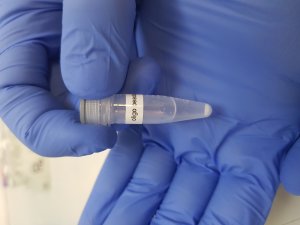When working with hard, non-deformable beads, on the Nadia platforms, it is important to follow several key actions to improve bead flowability and prevent the formation of bead blockages during runs.
The hard, non-deformable beads mentioned above are oligo-coated capture beads that can be purchased from the USA-based company ChemGenes. The beads are either available pre-filtered with a size range comprised between 20 and 40 µm, or unfiltered with a larger size range. When pipetting ChemGenes hard beads it is advised to use low retention tips to minimise the loss of beads.
1. Filtering ChemGenes beads

The first key step in preventing bead blockages is to filter both unfiltered and pre-filtered beads before use.
In the case of unfiltered beads, it is recommended to perform an initial filtration through a 70 µm cell strainer followed by a second filtration through a 40 µm cell strainer.

For pre-filtered beads it is still recommended to filter the beads through a 40 µm cell strainer for optimal performance. The bead filtration process is detailed in Chapter 5 of the scRNA-Seq and sNuc-Seq-on-Nadia protocols and involves washing beads with storage buffer (TE/Tween) to help them get through the strainer’s membrane.
2. Preparing ChemGenes bead aliquots
Once the beads have been filtered, another important step is to divide the bead suspension into aliquots containing enough beads for one Nadia run. Current standard Nadia protocols call for a concentration of 600 beads per µl. This concentration has been determined to ensure efficient cell capture rate while preventing high bead doublet rate. It is not recommended to use higher bead concentration as this would lead to an increased risk of blockages.
The preparation of bead aliquots is detailed in Chapter 5 of the scRNA-Seq and sNuc-Seq-on-Nadia protocols.

To estimate the bead concentration, it is important that the filtered bead suspension is well homogenised. An aliquot from the bead suspension is then taken and mixed with an equal volume of 20 % polyethylene glycol (PEG) solution, which will facilitate an even spread of the beads when loaded in a Fuchs Rosenthal haemocytometer C-Chip.

Using a light microscope, the user should ensure that the beads are evenly distributed throughout the grid of the slide before counting.
Instructions on how to count beads will be available in the corresponding haemocytometer slide manual.
 For a Fuchs-Rosenthal haemocytometer C-Chip, an average of the number of beads is taken in one of the 16 outer squares which are bordered by triple-lines. This number is multiplied by two to correct for the dilution factor and multiply again by five to get the number of beads per µl.
For a Fuchs-Rosenthal haemocytometer C-Chip, an average of the number of beads is taken in one of the 16 outer squares which are bordered by triple-lines. This number is multiplied by two to correct for the dilution factor and multiply again by five to get the number of beads per µl.

Based on the obtained bead count, the bead suspension is adjusted to 600,000 beads per ml, and divided into aliquots of 250 µl, each containing 150,000 beads. When aliquoting, it is crucial that the initial tube is inverted regularly to ensure that beads are evenly distributed between aliquots.
3. Storing ChemGenes bead aliquots

 Once aliquoted, it is crucial to store the beads appropriately to prevent them from becoming prone to clumping together.
Once aliquoted, it is crucial to store the beads appropriately to prevent them from becoming prone to clumping together.

 It is advised to store ChemGenes bead aliquots at 4°C, for up to 6 months. It is important to never freeze or vortex the beads, as these can cause beads to fracture.
It is advised to store ChemGenes bead aliquots at 4°C, for up to 6 months. It is important to never freeze or vortex the beads, as these can cause beads to fracture.
4. Loading ChemGenes beads in the Nadia

When performing an scRNA-Seq or sNuc-Seq experiment, the relevant number of ChemGenes bead aliquots (1 per sample) need to be re-suspended
in lysis buffer before loading into the Nadia instrument. To do this the beads must be pelleted to allow the removal of the buffer in which they are stored. This can be done by simply placing the aliquot upright on ice. The beads should pellet naturally within 10 minutes.

Alternatively, aliquots can be centrifuged at 1,000 x g, 4°C for no more than 10 seconds. It is important not to over-centrifuge the beads, as they will be more difficult to fully resuspend and more likely to cause chip blockages.
Immediately before loading the bead suspension in the Nadia chip, the user must ensure that the beads are well resuspended in the lysis buffer. This is done by pipetting the bead aliquot up and down around 10 to 20 times using a P200 pipette, until the suspension is homogenous. The resuspension step must be performed as rapidly as possible before loading the Nadia bead reservoir because the beads pellet very quickly.
 Once the beads are loaded, it is advised to swiftly proceed with the remaining cell loading and pressurisation steps of the protocol to avoid excessive pelleting of the beads within their reservoir.
Once the beads are loaded, it is advised to swiftly proceed with the remaining cell loading and pressurisation steps of the protocol to avoid excessive pelleting of the beads within their reservoir.
If you have performed all of these steps as described and are still experiencing bead blockages, please email our applications team at support@dolomite-bio.com.
Watch the full video ‘4 Key tips to optimise bead flow-ability’ here:
Further Reading
Drop-seq – Getting to the core of single cells one drop at a time


